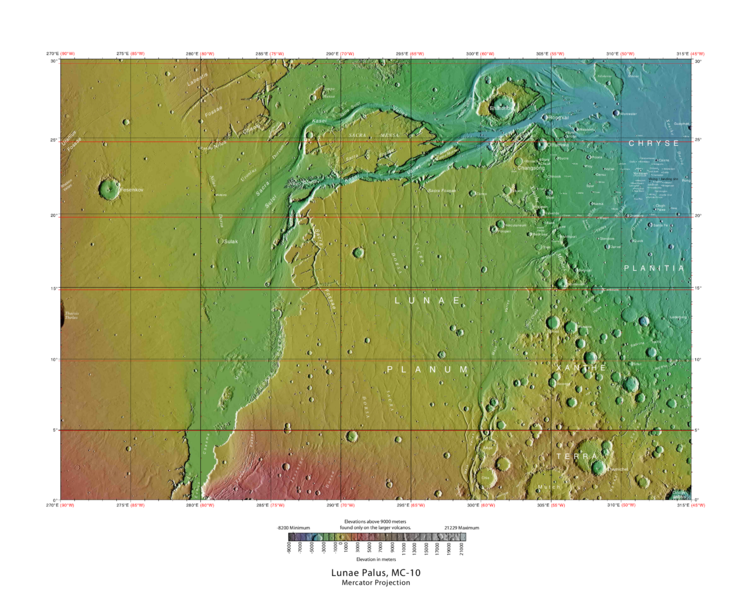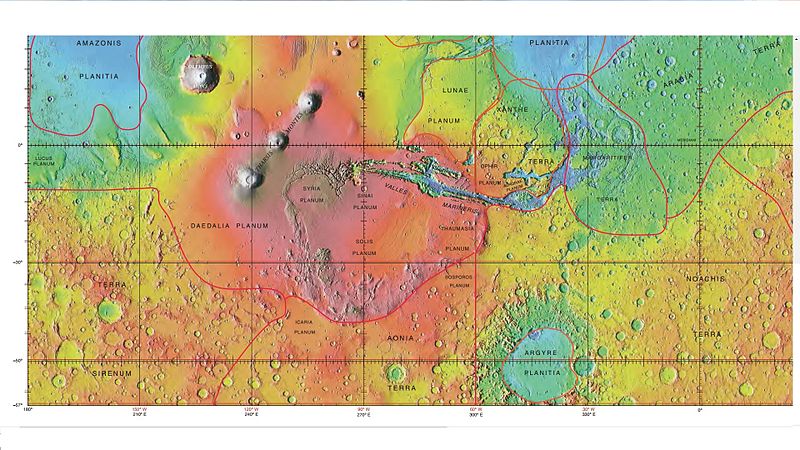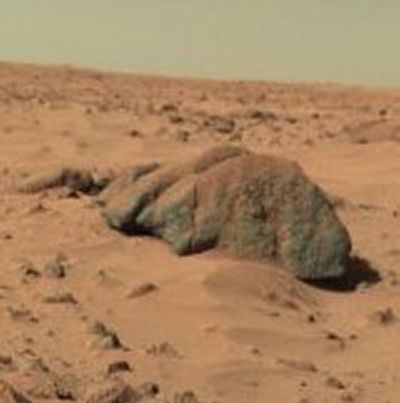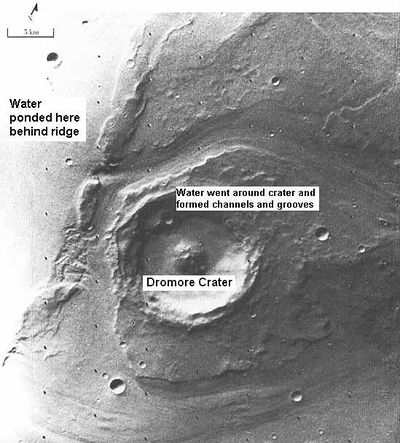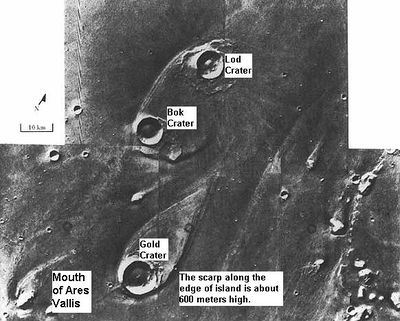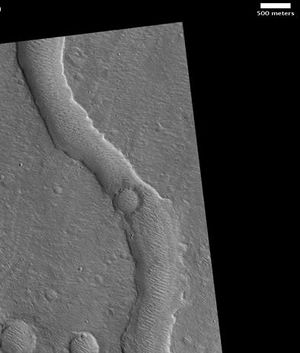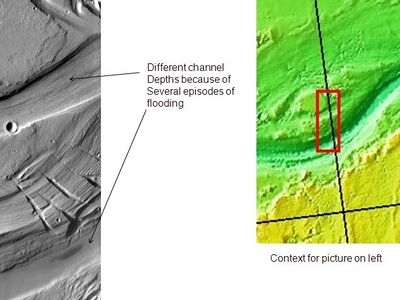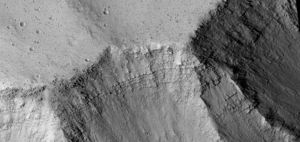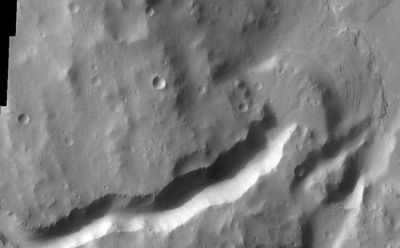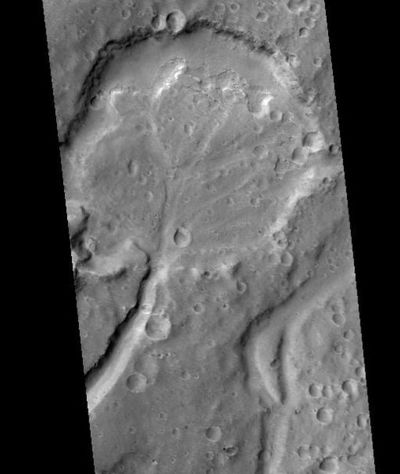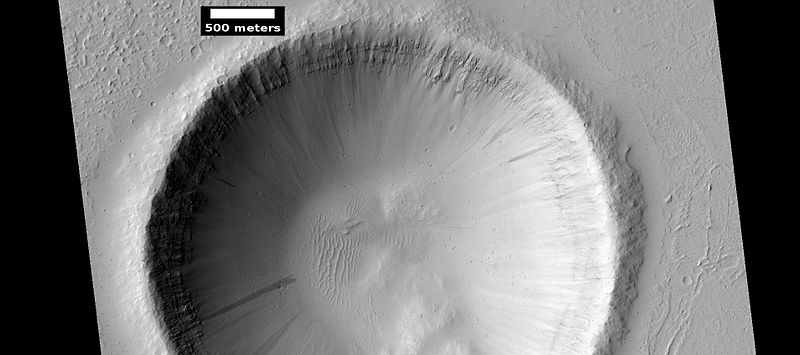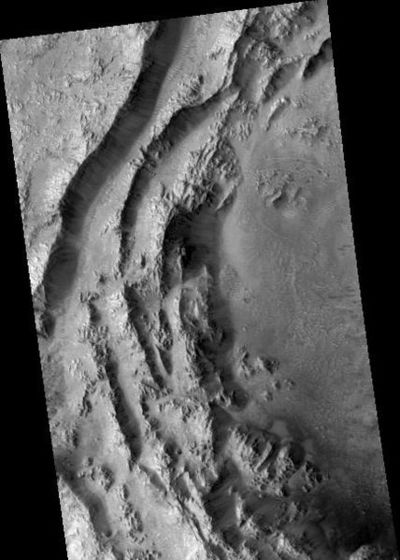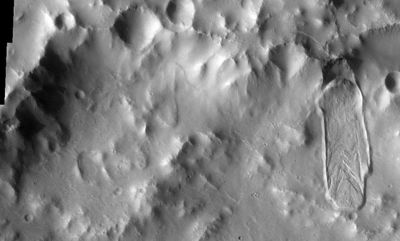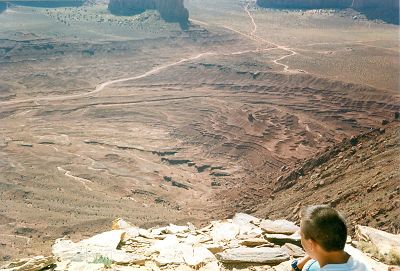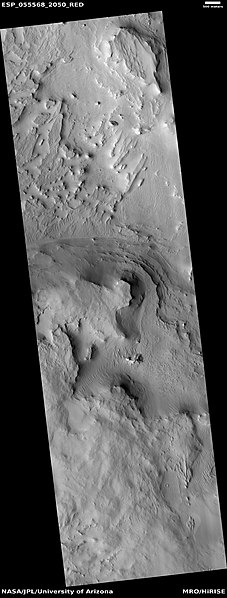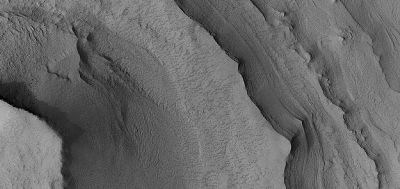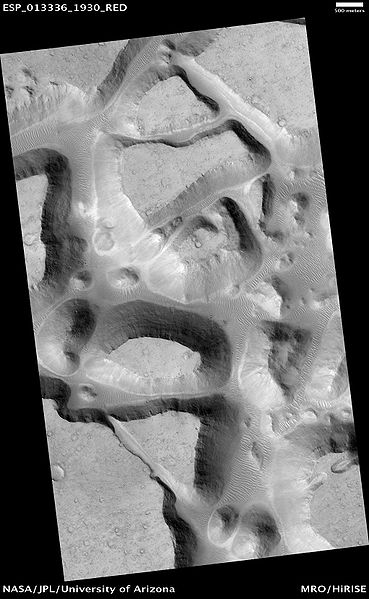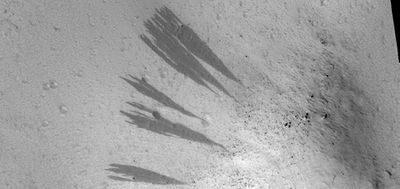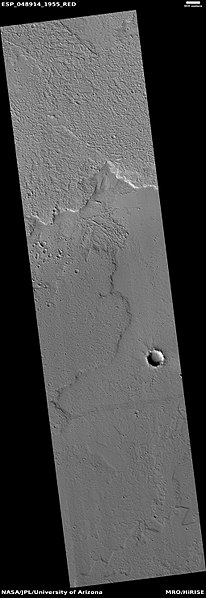Difference between revisions of "Lunae Palus quadrangle"
m (→See also) |
|||
| Line 102: | Line 102: | ||
| − | + | Ister Chaos, as seen by HiRISE | |
Revision as of 11:49, 24 January 2019
MOLA map showing boundaries for Lunae Planum and other regions. Colors indicate elevations.
The Lunae Palus quadrangle is one of a series of 30 quadrangle maps of Mars used by the United States Geological Survey (USGS) Astrogeology Research Program. The quadrangle is also referred to as MC-10 (Mars Chart-10).[1] Lunae Planum and parts of Xanthe Terra and Chryse Planitia are found in the Lunae Palus quadrangle. The Lunae Palus quadrangle contains many ancient river valleys. The quadrangle covers the area from 45° to 90° west longitude (315 E-270 E) and 0° to 30° north latitude. The Viking I Lander set down in the quadrangle on July 20, 1976, at 22.4 N and 47.5 W (312.5 E). It was the first robot spacecraft to successfully land on the Red Planet.[2]
Contents
Viking I Mission
File:Mars Viking 11a097wide.png|Dunes and rocks on Mars, as seen by Viking I Lander. Mars Viking 11d128.png|Trenches dug into the Martian surface by the Viking I Lander. The color is fairly accurate with the pink sky. The trenches are in the "Sandy Flats" area of the landing site at Chryse Planitia. The boom holding the meteorology sensors is at left. Click on image to see more details. Viking 1 found the Martian sky a light pink and many rocks. It found the wind speed to be the wind usually 7 meters per second (16 miles per hour). Some boulders displayed erosion by the wind.[3] Many small sand dunes were observed to be still active. Viking found a hard crust on the top of the soil that was comparable to a deposit, called caliche which is common in the U.S. Southwest.[4] [5] These crusts are formed by solutions of minerals moving up through soil and evaporating at the surface.[6]
The soil resembled those produced from the weathering of basaltic lavas. At this location the soil contained abundant silicon and iron, together with significant amounts of magnesium, aluminum, sulfur, calcium, and titanium. Trace elements, strontium and yttrium, were identified. Potassium levels were five times lower than the average for the Earth's crust. Some chemicals in the soil contained sulfur and chlorine that were like those remaining after the evaporation of sea water. Sulfur was more concentrated in the crust on top of the soil than in the bulk soil beneath. Scientists reasoned that the sulfur may be present as sulfates of sodium, magnesium, calcium, or iron; however, a sulfide of iron is also possible.[7] This finding was consistent with measurements from both the Spirit Rover and the Opportunity Rover ; hence, sulfates may be common on the Martian surface.[8] Using results from the chemical measurements, mineral models suggest that the soil could be a mixture of about 80% iron-rich clay], about 10% magnesium sulfate ([[kieserite?), about 5% carbonate (calcite), and about 5% iron oxides (hematite, magnetite, goethite?). These minerals are typical weathering products of mafic igneous rocks, such as basalt.[9] Studies with magnets aboard the landers showed that the soil is between 3 and 7 percent magnetic materials by weight. The magnetic chemicals could be magnetite and maghemite. These could come from the weathering of basalt rock.[10][11] Experiments carried out by the Mars Spirit rover (landed in 2004) indicated that magnetite could explain the magnetic nature of the dust and soil on Mars. Magnetite was found in the soil and that the most magnetic part of the soil was dark. Magnetite is very dark.[12] Viking did three experiments looking for life. The results were surprising and interesting. Most scientists now believe that the data were due to inorganic chemical reactions of the soil. But a few still believe the results were due to living reactions. No organic chemicals were found in the soil; hence nearly all the scientific community thought that no life was found because no organic chemicals were detected. Not finding any organics was unusual since meteorites raining on Mars for 5 billion years or so would surely bring some organics. Nevertheless, once must keep in mind that dry areas of Antarctica do not have detectable organic compounds either, but they have organisms living in the rocks.[13] Mars has almost no ozone layer, unlike the Earth, so UV light sterilizes the surface and produces highly reactive chemicals such as peroxides that would oxidize any organic chemicals.[14] Perchlorate may be the oxidizing chemical. The Phoenix Lander discovered the chemical perchlorate in the Martian Soil. Perchlorate is a strong oxidant so it may have destroyed any organic matter on the surface.[15] If it is widespread on Mars, carbon-based life would be difficult at the soil surface. The question of life on Mars received a new, important twist when research, published in the Journal of Geophysical Research in September 2010, proposed that organic compounds were actually present in the soil analyzed by both Viking 1 and 2. The study's authors found that perchlorate will destroy organics when heated and will produce chloromethane and dichloromethane-- the identical chlorine compounds discovered by both Viking landers when they performed the same tests on Mars. So, organic chemicals (maybe from organisms) may have initially been present in the soil but were broken down by perchlorate. [16]
Valles
"Vallis" (plural "valles") is the Latin word for valley. It is used for the naming of landform features on other planets. "Vallis" was used for old river valleys that were discovered on Mars, when we probes were first sent to Mars. The Viking Orbiters caused a revolution in our ideas about water on Mars; huge river valleys were found in many areas. Orbiting cameras showed that floods of water broke through dams, carved deep valleys, eroded grooves into bedrock, and traveled thousands of kilometers.[17] [18] [19]
River valleys observed by Viking orbiters
The Viking Orbiters caused a revolution in our ideas about water on Mars. Huge river valleys were found in many areas. They showed that floods of water broke through dams, carved deep valleys, eroded grooves into bedrock, and traveled thousands of kilometers.[20] [21] [22]
Mars Science Laboratory
Hypanis Vallis, in the Lunae Palus quadrangle, was one of the sites proposed as a landing site for the Mars Science Laboratory. [23] and to examine its sediment layers. The site eventually settled on for the Mars Science Laboratory landing was Gale Crater in the Aeolis quadrangle.
Kasei Valles
One of the most significant features of the Lunae Palus region, Kasei Valles, is one of the largest outflow channels on Mars. Like other outflow channels, it was carved by liquid water, probably during gigantic floods. Kasei is about 2,400 km (1500 miles) long. Some sections of Kasei Valles are 300 km (190 miles) wide. It begins in Echus Chasma, near Valles Marineris, and empties into Chryse Planitia, not far from where Viking 1 landed. Sacra Mensa, a large tableland, divides Kasei into northern and southern channels. It is one of the longest continuous outflow channels on Mars. At around 20° north latitude Kasei Valles splits into two channels, called Kasei Vallis Canyon and North Kasei Channel. These branches recombine at around 63° west longitude. Some parts of Kasei Valles are 2–3 km deep.[24] Scientists suggest it was formed several episodes of flooding and maybe by some glacial activity.[25]
The map at the right shows relationships among Kasei Valles, Bahram Vallis, Vedra Valles,Maumee Valles, and Maja Valles. Map location is in Lunae Palus quadrangle and includes parts of Lunae Planum and Chryse Planitia.
Deltas
Researchers have found a number of examples of deltas that formed in Martian lakes. Finding deltas is a major sign that Mars once had a lot of water. Deltas often require deep water over a long period of time to form. Also, the water level needs to be stable to keep sediment from washing away. Deltas have been found over a wide geographical range.[26]
Impact Craters
Crater showing layers, as seen by HiRISE under HiWish program
Impact craters generally have a rim with ejecta around them, in contrast volcanic craters usually do not have a rim or ejecta deposits. As craters get larger (greater than 10 km in diameter) they usually have a central peak.[27] The peak is caused by a rebound of the crater floor following the impact.[28] Sometimes craters will display layers. Craters can show us what lies deep under the surface.
Layers
More pictures from Lunae Palus quadrangle
Ister Chaos, as seen by HiRISE
See also
- High Resolution Imaging Science Experiment (HiRISE)
- Geography of Mars
- Layers on Mars
- Rivers on Mars
- Viking 1
References
- ↑ Davies, M.E.; Batson, R.M.; Wu, S.S.C. “Geodesy and Cartography” in Kieffer, H.H.; Jakosky, B.M.; Snyder, C.W.; Matthews, M.S., Eds. Mars. University of Arizona Press: Tucson, 1992.
- ↑ On Mars: Exploration of the Red Planet. 1958–1978, SP-4212. (NASA)
- ↑ Mutch, T. et al. 1976. "The Surface of Mars: The View from the Viking 2 Lander". Science: 194. 1277–1283.
- ↑ Clark, B. et al. 1978. Implications of Abundant Hygroscopic Minerals in the Martian Regolith. Icarus: 34. 645–665
- ↑ Toulmin III, P. et al. 1977. "Geochemical and Mineralogical Interpretation of the Viking Inorganic Chemical Results". Journal of Geophysical Research: 82. 4624–4634
- ↑ Arvidson, R. A. Binder, and K. Jones. 1976. "The Surface of Mars". Scientific American: 238. 76–89.
- ↑ Clark, B. et al. 1976. "Inorganic Analysis of Martian Samples at the Viking Landing Sites". Science: 194. 1283–1288.
- ↑ Press Release Images: Opportunity. 25 June 2004 (JPL/NASA)
- ↑ Baird, A. et al. 1976. "Mineralogic and Petrologic Implications of Viking Geochemical Results From Mars: Interim Report". Science: 194. 1288–1293.
- ↑ Hargraves, R. et al. 1976. Viking Magnetic Properties Investigation: Further Results. Science: 194. 1303–1309.
- ↑ Arvidson, R, A. Binder, and K. Jones. "The Surface of Mars". Scientific American
- ↑ Bertelsen, P. et al. 2004. "Magnetic Properties Experiments on the Mars Exploration rover Spirit at Gusev Crater". Science: 305. 827–829.
- ↑ Friedmann, E. 1982. "Endolithic Microorganisms in the Antarctic Cold Desert". Science: 215. 1045–1052.
- ↑ Hartmann, W. 2003. A Traveler's Guide to Mars. Workman Publishing. NY NY.
- ↑ NASA Attempts to Quash Mars Rumors. Cara McDonough, August 7, 2008.
- ↑ NASA/Jet Propulsion Laboratory. "Did Viking Mars landers find life's building blocks? Missing piece inspires new look at puzzle." Science Daily 5 September 2010.
- ↑ author=Hugh H. Kieffer|title=Mars|url=https://books.google.com/books?id=NoDvAAAAMAAJ%7Caccessdate=7 March 2011|date=1992|publisher=University of Arizona Press|isbn=978-0-8165-1257-7
- ↑ Raeburn, P. 1998. Uncovering the Secrets of the Red Planet Mars. National Geographic Society. Washington D.C.
- ↑ Moore, P. et al. 1990. The Atlas of the Solar System. Mitchell Beazley Publishers NY, NY.
- ↑ *Kieffer, H., et al. (eds) 1992. Mars. The University of Arizona Press. Tucson
- ↑ Raeburn, P. 1998. Uncovering the Secrets of the Red Planet Mars. National Geographic Society. Washington D.C.
- ↑ Moore, P. et al. 1990. The Atlas of the Solar System. Mitchell Beazley Publishers NY, NY.
- ↑ http://themis.asu.edu/features/ianichaos
- ↑ Baker, V. 1982. The Channels of Mars. University of Texas Press. Austin
- ↑ http://themis.asu.edu/features_kaseivalles
- ↑ Irwin III, R. et al. 2005. "An intense terminal epoch of widespread fluvial activity on early Mars: 2. Increased runoff and paleolake development". Journal of Geophysical Research: 10. E12S15
- ↑ http://www.lpi.usra.edu/publications/slidesets/stones/
- ↑ Kieffer, H., et al. (eds) 1992. Mars. The University of Arizona Press. Tucson
- ↑ http://www.marsartgallery.com/marsnames.html
- ↑ Skinner, J., L. Skinner, and J. Kargel. 2007. Re-assessment of Hydrovolcanism-based Resurfacing within the Galaxias Fossae Region of Mars. Lunar and Planetary Science XXXVIII (2007)
References
Recommended reading
- Baker, V. 1982. The Channels of Mars. Univ. of Tex. Press, Austin, TX
- Grotzinger, J., R. Milliken (eds.). 2012. Sedimentary Geology of Mars. Tulsa: Society for Sedimentary Geology.
- Kieffer, H., et al. (eds) 1992. Mars. The University of Arizona Press. Tucson
